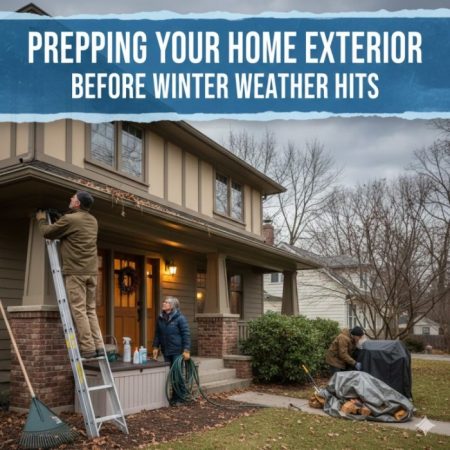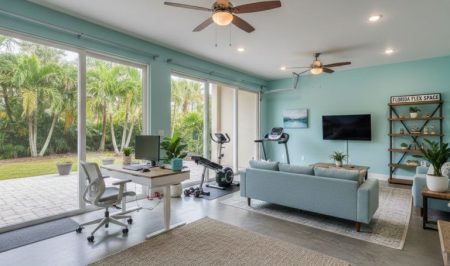If you’re getting ready to paint the exterior of your home, read on for tips to prepare you for a successful job. Moisture is the biggest enemy of a painter, but it isn’t the only thing you should be concerned about. You’ll need the right tools, such as brushes, rollers, sprays, and a paint calculator, to ensure that you get the most paint on the walls.
Primer essentials
Primer is an excellent way to protect the surfaces you will be painting. It helps the paint stick to the surface and seals in moisture. In addition, it can mask bad wall conditions. The proper use of primer is essential to the longevity of your paint job.
Primer is usually applied with a sprayer, roller, or brush. Some painters prefer to use an oil-based primer. This type of primer penetrates wood surfaces.
Priming a surface is not free. It will require you to invest some time, money, and effort. You’ll also need to remove old paint. Old paint might contain lead, a known cause of brain development problems. If you need to remove it, you can use a commercial cleaner.
Painting a home is a big project. Exterior prep work includes sanding and scraping, caulking and sealing, and repairing holes. For a three-story house, the average cost is between $4,000 and $10,000.
Brushes, rollers, and sprays are best for exterior painting
Whether a DIYer or a professional, you must choose the best exterior painting tools. Brushes, rollers, and sprays are your three options. While they may be different from one another, they all give you the same basic advantages.
Brushes offer the best paint adhesion. They also allow you to build up coverage in smaller areas. For this reason, they are ideal for cutting in around windows and trim.
Paint rollers are also good choices, especially for large flat surfaces. But they are more difficult to use. Using the wrong tool can result in a big mess. Also, rollers pick up and release less paint than brushes.
Sprayers can also be used, but they require more cleanup. They’re faster, but they can also cause drips and oversprays. Moreover, they aren’t suitable for small, complex surfaces.
Lastly, paintbrushes are your best bet for delicate, detailed work. If you’re a painter, you need to ensure that the primer you’re using is compatible with the surface.
Plan your project during favorable conditions
The most important outside paint job requires three weekends of good weather, so keep that in mind if you intend to work on your painting project on the weekends. Give yourself wiggle room in case unexpected rain or humidity appears. Set up a month during the dry season, between 50 and 80 degrees Fahrenheit, for your project to be on the safe side.
Your uncured paint coat can blister if you paint outside in bad weather. If your home has more than one story, you’ll also need a sturdy ladder or a scaffold. Of course you can always look for exterior house painters near me to complete the entire job in a day or two if you live in a very wet climate.
Calculate how much paint you need for exterior walls
The first step in calculating how much paint you need for exterior walls is to measure the height and length of the walls. Once you have that information, you can calculate how many square feet you will need to cover.
For example, a two-story house has a total of 328 square feet of wall area. That number needs to be subtracted from the height of the doors and windows.
You can use a reference table for these calculations. They’re quick and easy to use.
Another way to determine how much paint you need is to use the formula found on the back of most paint containers. Most paint manufacturers estimate that their product covers 400 square feet per gallon. It’s important to keep in mind that different surfaces absorb paint in different ways. This means you may need to apply more paint than the calculation indicates.
You will need to apply more paint if you’re working with textured walls. In addition, the quality of the paint you choose will also affect the amount of paint you need. Higher-quality paints will provide good hide and coverage. However, cheaper paints may need to perform better.
Organize and tidy up the area
Patio furniture, barbecues, and trash cans should be moved from near the house and placed away from the wall. Drop cloths and painter’s tape on outlet boxes and fixtures, then cover them. Trim the shrubs and trees, and drop cloth the landscape.
Time to start painting
The moment has come to make your house sparkle. Use painter’s tape to secure plastic sheeting to your mailbox, lighting fixtures, doors, and trim before painting. Fill your sprayer with your chosen color of flat or eggshell latex paint. Apply one or two coats to the whole house, covering it from top to bottom as necessary.
Your time will be shortened in half if you backroll with two painters. While one person sprays the home, another follows with a roller to smooth off the paint that has been sprayed.
When your trim is prepared for painting, remove the plastic sheeting covering it. Select an accent trim color with a semi-gloss finish for a stylish appearance.
If you’re getting ready to paint the exterior of your home, read on for tips to prepare you for a successful job. Moisture is the biggest enemy of a painter, but it isn’t the only thing you should be concerned about. You’ll need the right tools, such as brushes, rollers, sprays, and a paint calculator, to ensure that you get the most paint on the walls.
Primer essentials
Primer is an excellent way to protect the surfaces you will be painting. It helps the paint stick to the surface and seals in moisture. In addition, it can mask bad wall conditions. The proper use of primer is essential to the longevity of your paint job.
Primer is usually applied with a sprayer, roller, or brush. Some painters prefer to use an oil-based primer. This type of primer penetrates wood surfaces.
Priming a surface is not free. It will require you to invest some time, money, and effort. You’ll also need to remove old paint. Old paint might contain lead, a known cause of brain development problems. If you need to remove it, you can use a commercial cleaner.
Painting a home is a big project. Exterior prep work includes sanding and scraping, caulking and sealing, and repairing holes. For a three-story house, the average cost is between $4,000 and $10,000.
Brushes, rollers, and sprays are best for exterior painting
Whether a DIYer or a professional, you must choose the best exterior painting tools. Brushes, rollers, and sprays are your three options. While they may be different from one another, they all give you the same basic advantages.
Brushes offer the best paint adhesion. They also allow you to build up coverage in smaller areas. For this reason, they are ideal for cutting in around windows and trim.
Paint rollers are also good choices, especially for large flat surfaces. But they are more difficult to use. Using the wrong tool can result in a big mess. Also, rollers pick up and release less paint than brushes.
Sprayers can also be used, but they require more cleanup. They’re faster, but they can also cause drips and oversprays. Moreover, they aren’t suitable for small, complex surfaces.
Lastly, paintbrushes are your best bet for delicate, detailed work. If you’re a painter, you need to ensure that the primer you’re using is compatible with the surface.
Plan your project during favorable conditions
The most important outside paint job requires three weekends of good weather, so keep that in mind if you intend to work on your painting project on the weekends. Give yourself wiggle room in case unexpected rain or humidity appears. Set up a month during the dry season, between 50 and 80 degrees Fahrenheit, for your project to be on the safe side.
Your uncured paint coat can blister if you paint outside in bad weather. If your home has more than one story, you’ll also need a sturdy ladder or a scaffold. Of course you can always look for exterior house painters near me to complete the entire job in a day or two if you live in a very wet climate.
Calculate how much paint you need for exterior walls
The first step in calculating how much paint you need for exterior walls is to measure the height and length of the walls. Once you have that information, you can calculate how many square feet you will need to cover.
For example, a two-story house has a total of 328 square feet of wall area. That number needs to be subtracted from the height of the doors and windows.
You can use a reference table for these calculations. They’re quick and easy to use.
Another way to determine how much paint you need is to use the formula found on the back of most paint containers. Most paint manufacturers estimate that their product covers 400 square feet per gallon. It’s important to keep in mind that different surfaces absorb paint in different ways. This means you may need to apply more paint than the calculation indicates.
You will need to apply more paint if you’re working with textured walls. In addition, the quality of the paint you choose will also affect the amount of paint you need. Higher-quality paints will provide good hide and coverage. However, cheaper paints may need to perform better.
Organize and tidy up the area
Patio furniture, barbecues, and trash cans should be moved from near the house and placed away from the wall. Drop cloths and painter’s tape on outlet boxes and fixtures, then cover them. Trim the shrubs and trees, and drop cloth the landscape.
Time to start painting
The moment has come to make your house sparkle. Use painter’s tape to secure plastic sheeting to your mailbox, lighting fixtures, doors, and trim before painting. Fill your sprayer with your chosen color of flat or eggshell latex paint. Apply one or two coats to the whole house, covering it from top to bottom as necessary.
Your time will be shortened in half if you backroll with two painters. While one person sprays the home, another follows with a roller to smooth off the paint that has been sprayed.
When your trim is prepared for painting, remove the plastic sheeting covering it. Select an accent trim color with a semi-gloss finish for a stylish appearance.






